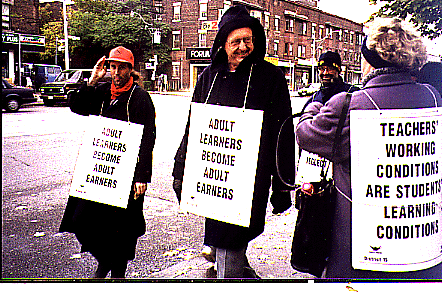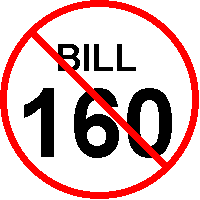-
back to PART TWO
- Day 7: Tuesday 4 Nov.
- Day 8: Wednesday 5 Nov.
- Day 9: Thursday 6 Nov.
- Day 10: Friday 7 Nov.
- Defeat at the Commercial Level
- The Curriculum of the Street Classroom
- Lessons Concerning the Media
- Immaginary Epilogue
- What Happened Since 7 Nov.
Part THREE:
|
. 24 26 27 |
.
.
.
.
Introduction to Part THREE
Others within the union felt that what was called for at this stage of the protest was that we extend the struggle to hurt the powers that be where they feel it: not their children being out of school, but the commercial sector being affected. To date this had not happened. Even the days of protest over the past year had a negligible impact on the commerce of Ontario. What was needed were spirit-raising actions to provoke this broadening of the struggle. A sit-in at Dave Johnson's Ministry of Education office was planned and ready to go --it was just a question of timing. It was also during this period that some protestors started talking about other forms of non-violent activism. These plans led to, amongst other actions, teachers starting a fast at Trinity-St. Paul's United Church. |
.
.
DAY SEVEN: Tuesday 4 Nov.
Now that the injunction had failed, there was a general recognition that all of this would have to get more serious. Talks between the union leaders and the government were resumed but few of us held much hope in these. We felt that this was going to be resolved in the streets and not in the board rooms. The headline of the Toronto Star was "Teachers' strike: No end in sight" Johnson is quoted as refering to having to go to the courts as "legal mumbo jumbo". This coming from a Minister who respects the law and accuses us "illegal strikers" as being "lawless". It is no surprise that under 160 the Minister's decisions are final and unchallengable by any court.
Late that afternoon I went to my "Non-school Settings for Education" class at OISE. After that class there was a meeting at the Bloor St. United Church on Bill 160 and the protest action. |
DAY EIGHT: Wednesday 5 November
Today was to be the "Take Your Kids to Work" day. After picketting at Oakwood C. I. all morning there was a meeting at noon at the Croft Chapter House. The Toronto Star today had the headline: "Teachers ponder ending walkout" . . .
|
DAY NINE: Thursday 6 November
After picketing all morning, I went to my 3308F class at OISE. This was another day where a large rally was planned at Queen's Park. On my way to class on the subway, there were many teachers (and others) carrying signs. Many wore buttons and some even had the green ribbon on already. It seemed that we were all concerned about what today would hold. I again left the class early in order to hear at least some of the speeches at Queen's Park. On the way, I noticed the front page of the Toronto Star: "Militant teachers to stay on strike"
. . . .
. . .
I personally was pleased, therefore, that immediately next on my agenda was the regularly scheduled (first Thursday of every month) District 15 Council meeting. I knew that all of the major players in Toronto would be there and we would be able to get some answers. Before getting down to the state of the protest, however, we had to do some other union business. I am already an elected council member, but I was also standing for election to the Metro Assembly as a delegate. This election went well as myself and other "like minded" brothers and sisters were elected. The rest of the meeting went less well. While I had hoped for some clear answers about our stragegy, everyone seemed confused. To me and many others the next step was clear -we had to call for a general strike. This type of escalation was essential. A motion to that effect was passed almost unanimously. Immediately following the meeting, many of us sat around in the steelworkers hall listening to the radio. We had heard that there would be some "announcement" from certain of the affiliates at 8:00pm. Finally Maret Sadem-Thompson, FWTAO, announced that they were not giving up, but that they were going back to the classroom Monday. There was a very emotional response from all present to this announcement. |
.
.
DAY TEN: Friday 7 November
This was the day after the night before. The headline of the Toronto Star read "It's back to school" This was to have been a Professional Development day. A few of us had organized a visit down to the Workers' Arts and Heritage Centre in Hamiliton. Instead, here we were again in front of Oakwood C. I. At the time we did not know that this would be our last picket day. Most of thought we would be going it alone -or perhaps with the OECTA strikers. We took an informal straw vote amongst ourselves to that effect, although we recognized that this was decision that would be taken at a much higher level. We visited the picket line teachers of local elementary school teachers and spoke with them about how they felt. Some swore they would defy their union leadership and stay out as long as the secondary teachers did. Some expressed feelings of being betrayed by their leadership.

This was the day that there was the first of two meetings of the Toronto Teachers Federation at the Hummingbird Centre. Originally only one had been scheduled. Although I was not there (the TTF is the elementary public school teachers of Toronto) my brother was. According to him the mood and events at that meeting were very dramatic --but unreported by the press. Many teachers were upset by the union leadership's decision to announce that they would go back --especially since the membership had not been adequately consulted. There were, amongst other things, demands for an all-member vote to be taken as to whether to follow the leadership's decsion to go back Monday. The response by the leaders was that there was no time for an all-member vote, unless it could be at another such mass meeting. Another such meeting (for example at the Hummingbird Centre) was not possible,thought, because it would cost $5,000. and the union could just not afford it. When this was said, members spontaneously got up out of their seats, when down to the front, and threw money onto the stage. Small bills, personal cheques, and even coins pilled up on the stage at the feet of the union leaders. Eventually $5,000. worth was raised and the leaders gave in and called another meeting for two days later. This was also the first day of a conference at OISE on Global Dimensions of Corporate Rule. Many teachers are concerned about corporated intrusions into public education and this conference was a timely connection between the protest and the larger context. Several members of the political action sub-group decided to go ahead with the sit-in at the Ministry of Education. This precipitated differences of opinion because originally the idea had been that we should plan ahead such an action to be prepared to respond to repressive actions which we anticipated might have been taken by the government. The central question was always how and when to attempt to escalate the struggle. Four brothers occupied outer offices of the Minister of Education that afternoon. Immediately press releases were distributed and unions were solicited to endorse the action. A press release was taken to the OSSTF Provincial Council meeting that (late) afternoon, and they voted to support the sit-in. Later, the next week, a few of the same members who had occupied the offices, also started a fast at Trinity-St. Paul's United Church. |
Lessons from the Commercial Struggle
Defeat at the Commercial Level
. . .
. . An Immaginary Epilogue
What Happened Since 7 November
Later that day, the fourth of the five federations, the Roman Catholic OECTA announced that they too were going back Monday. On Sunday, 9 Nov. there was the second meeting of the TTF. Despite heated debate, the outcome of the vote was that the elementary public school teachers would follow their leaders decision to go back Monday.
Back to School
The Sit-in at the Min. of Education
Back in the Legislature
Monday 1 Dec. Bill 160 passed (81 - 48) third and final reading and became law.
|
to continue to the SUMMARY and CONCLUSIONS
.


 After picketing all
morning, I had yet another meeting with a teachers' group.
After picketing all
morning, I had yet another meeting with a teachers' group.
 Rumour is that although publicly the unions are still united and strong,
privately
they are split. The elementary teachers want to declare victory and go
back to the classroom a.s.a.p. Secondary teachers, such as myself, are
braced for a long strike.
Rumour is that although publicly the unions are still united and strong,
privately
they are split. The elementary teachers want to declare victory and go
back to the classroom a.s.a.p. Secondary teachers, such as myself, are
braced for a long strike.
 Annie Kidder spoke
representing People for Education. They
speerheaded the "green ribbon campaign". Apple green ribbons were being
put up all over: on trees, on fences, on doors.
Annie Kidder spoke
representing People for Education. They
speerheaded the "green ribbon campaign". Apple green ribbons were being
put up all over: on trees, on fences, on doors.
 What concerned many of us at that time was that most of the speakers used
the past tense. The tone was that "We had put up a good fight".
Most of us were very anxious about what this meant.
What concerned many of us at that time was that most of the speakers used
the past tense. The tone was that "We had put up a good fight".
Most of us were very anxious about what this meant.
 Our president, Earl Manners, could be seen in what appeared to be
an argument on the podium with other affiliate leaders. We knew from
the tone that the split between the affiliates had broadened, but the
rank-and-file members such as myself did not know for certain yet whether
the split was enough to end the strike.
Our president, Earl Manners, could be seen in what appeared to be
an argument on the podium with other affiliate leaders. We knew from
the tone that the split between the affiliates had broadened, but the
rank-and-file members such as myself did not know for certain yet whether
the split was enough to end the strike.

